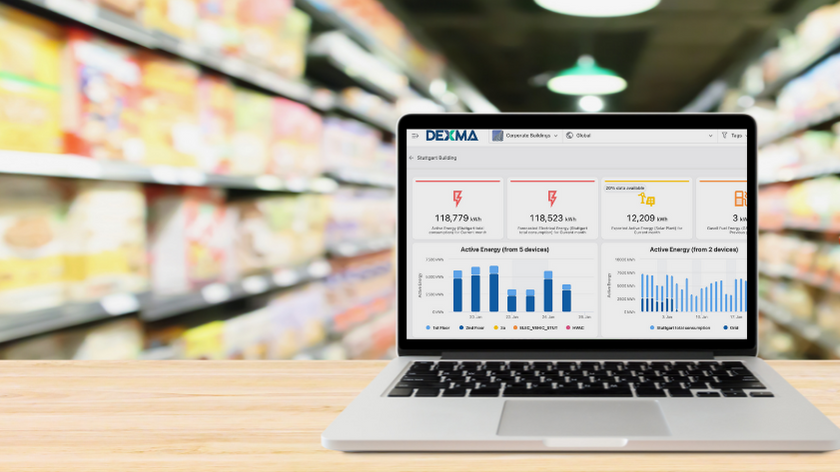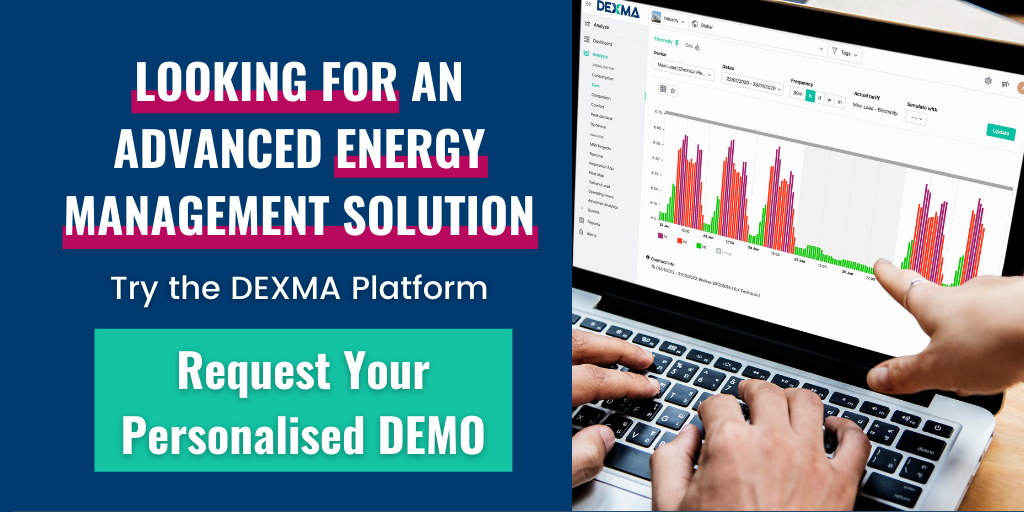Managing energy in a supermarket chain or retail store takes a lot of effort and knowledge. The same happens for maintenance and facility management. You probably have some software to help you with the job, while also using spreadsheets and manual control. If you want to learn more about how to integrate EMS and CMMS solutions to make the most of energy and maintenance in retail buildings, keep on reading.
What are EMS and CMMS?
First, let’s take a quick look at the definition of an EMS and CMMS, and their similarities and differences.
An Energy Management System (EMS) is a software designed to monitor and control energy usage. It collects, analyses and compares data to provide users with useful information to help them optimise energy usage. The DEXMA Platform is an example of EMS.
A Computerised Maintenance Management System (CMMS) is an online tool designed to manage and optimise maintenance to help Facility Management professionals be more productive. Generally, it focuses on machinery and equipment, so you can manage all aspects from repairs, orders, replacements and regular maintenance.
How are these two tools similar?
What an EMS and CMMS have in common is that they are tools designed to help professionals in their day-to-day jobs. Whether it is by monitoring real time data, predicting anomalies or identifying issues with machinery, they are a resource for professionals.
The final goal of these tools is to help professionals be more efficient, by using technologies, helping them to be more productive and hence save in costs in the mid to long term.
Also, both are software solutions, increasingly provided as Software as a Service. I.e, you don’t buy a license for life, you buy an access fee for a software that is maintained online and that is accessible from multiple locations (desktop, app, etc), with technical support service included.
Why do you need EMS and CMMS in Retail?
Retail facilities depend highly on energy.
Whether it is lighting and HVAC in shops, or machinery for refrigeration in supermarkets, energy is a factor to keep in mind. That’s why an EMS is helpful for you to manage these facilities. And when it comes to Facility Management, CMMS is what you’re looking for.
Taking into account the size of your facilities and the number of locations, managing them all without the help of a specific software is definitely a difficult task. That’s why keeping track of your facility’s energy consumption and the state of your machinery is key for you.
Spreadsheets and manual evaluation probably work for you on your day-to-day in retail buildings. But using a specialised solution can help you undertake some tasks faster and more effectively, comparing, and storing data, so you can focus on other areas of work with added value.
EMS and CMMS solutions are already helpful individually, and you probably see value in them. But integrating them can provide you with even more insights, ensuring the tools help one another and share information, so you can have a complete understanding of your facilities. In real time.
What if you could automatically see consumption over all your locations? What if you could quickly identify which shops perform better than others in energy terms? Or what if the integration between your EMS and CMMS in retail could help you with your preventive maintenance to fix your machinery before it’s too late?
Let us set an example.
A supermarket relies on a large number of fridges, and HVAC is controlled for the right temperature. A breakage could have an enormous impact for you. Imagine the fridges where you keep fresh meat and dairy fail. Will you be able to fix them quickly enough, or will you have to discard all the produce, with the loss of money and the food waste involved?
We know this doesn’t happen all the time, but you need to be prepared for it.
If you wait for the fridges to fail, and then you fix them, you’re doing corrective maintenance. That is, fixing something when it has already failed or been broken. You will eventually fix them, but you may have to wait for parts to arrive, or for a specific technician, and that will take longer to repair. This method is still in use, specially across smaller businesses or those who don’t see value in software investment.
But if your strategy was based on preventive maintenance, supported by an EMS and CMMS, you would have been alerted of the problems to foresee the breakage and find a solution before the break occurred. This method is now widespread, as it is generally easier and cheaper to maintain your appliances by identifying minor problems rather than fixing or replacing an entire set of machinery.
Software solutions can help you be more proactive. Of course, breakages can occur anyway and surprise you. But having a strategy in place and specialised software can help you be more efficient in fixing them, as well as identifying patterns or preventing failures in the future.
Like anything in business, there isn’t a written rule book for every decision to make. However, it is useful to combine your software solutions so they can join forces, share data and provide you with even further insights.
How to Integrate an EMS and CMMS
In today’s connected work environment, most of these solutions can be connected and share information. Specially, if the software is on the cloud (provided as Software as a Service), data between them can be shared easily and automatically.
Information from sensors and meters – both from energy smart meters and from particular machinery – is processed and shared between the software solutions, which translate it into useful information for you as a user. This can be energy consumption, peaks of usage, or malfunctions, among others.
With the support of your energy management team, the first step in integrating your EMS and your CMMS will be to decide what information you want to obtain and how many data points you will need. And remember, one meter does not equal a data point. Each meter can provide you with several strings of information. More information on data points here.
When setting up the software, your professional team can advise on the best way to connect your EMS and CMMS, and what type of information you need from them. They will have to be set up with the right communication protocols to share information. Here are some available gateways to connect to your EMS. In case you want to know more about EMS and integrations, get in touch with our experts.
Keep in mind that, besides integrating your facility management solutions, you need to make sure that you and your team are up to speed with the different functionalities they have, so you can make the most of it.
Energy Intelligence solutions such as the DEXMA Platform can be integrated with your CMMS provider to share data between them and maximise the benefits. The DEXMA Optimise solution, in particular, detects anomalies in the system thanks to 24/7 data gathering energy intelligence. If it finds a problem, it alerts the CMMS, so you can check what isn’t working and how to solve it.
But what if you’re still working on spreadsheets and you don’t have a dedicated software yet? No problem, one step at a time. You can set them up, and get them up and running simultaneously, benefitting from the integration from day one.
Of course, there are several software options to choose from, whether on-premise or in the cloud. Speak to your provider or get in touch with our experts to discuss your software needs and how your different systems can be integrated.




